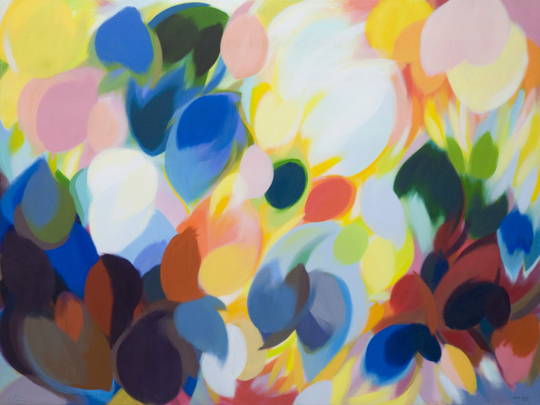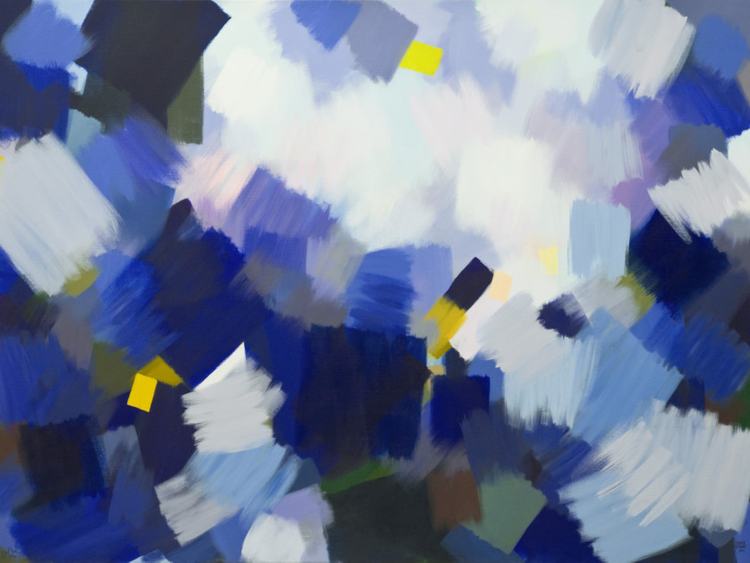
Ayyam Gallery Dubai is hosting two exhibitions that showcase very different facets of Samia Halaby’s art and life. The larger exhibition, Illuminated Space, reflects the latest experiments in abstraction by the New York-based artist who is recognised as a leading abstract painter and a pioneer of contemporary abstraction in the Arab world. The other show, Documentary Drawings of the Kafr Qasem Massacre, reflects Halaby’s role as an activist committed to raising her voice against the injustices suffered by Palestinians. It features realistic figurative drawings and paintings based on her long-term research and documentation of the massacre of 49 Palestinians by Israeli border guards in the village of Kafr Qasem in 1956.
Halaby was born in Occupied Jerusalem in 1936 and grew up in Jaffa. Her family moved to the United States in 1951, where she received her bachelor’s degree in design and a master’s in fine arts. She has taught at universities across the United States, and was the first full-time female associate professor at the Yale School of Art. Her contributions to American academia include a groundbreaking undergraduate studio art programme that she introduced to art departments all over the Midwest.
Throughout her career, she has been interested in investigating the materialist principles of abstraction and finding new ways to represent reality through form. Her work is influenced by Islamic geometric abstraction and the abstract movements of the Russian avant-garde, but she constantly experiments with new techniques and media to depict what she sees around her in an abstract language.
Over the last two years she has been interested in exploring what she describes as “the space of light”, by approaching the concept of luminosity based on the relative saturation that is found in the abstract paintings of Mark Rothko and Ad Reinhardt.
“As a painter I think about how things look and how our movement affects what we see and understand what we see. I pay special attention to the boundaries of things, their intersections, texture, density, weight, speed and their relative distance to each other and to me as I am looking at them. The difference in speed between near and far things relative to our motion, the time it takes for an object to move from one location to another, how such movement defines space, and how space is translatable into time, are all essential considerations in my visual thinking. When I walk around my neighbourhood at night, I am fascinated by how the trees look in artificial light, and the way the trees, buildings and neon signs combine. But my main concern in this body of work was light and making abstractions based on the actual space of light that I see,” she says.
Although some of the paintings in this series are inspired by her memories of cities such as Beirut and Petra, Halaby has mostly taken the ambience of her New York apartment and the daily activity in her neighbourhood that she observes from her window at different times of the day, as reference points for how light is depicted in abstraction. Through the interaction of geometric forms and colours on her canvases, she eloquently conveys the intermingling of trees, skyscrapers, the ebb and flow of people and traffic, and the interplays of natural and artificial light that shape the city.
For instance, View from Fire Escape, depicts a nocturnal scene, with an orange rectangular form representing the dim light inside her home, blue and purple quadrilaterals showing the darkness outside, and pink, orange and yellow squares marking the neon glow of the store fronts in the distance; whereas in Brick City at Night, she has used tonal variations to illustrate degrees of illumination.
Although Halaby has lived away from her homeland since her family was forced to leave Jaffa in 1948, she continues to be deeply engaged with Palestine, both as a scholar and promoter of Palestinian art, and as an activist raising her voice against the Israeli occupation of Palestine. Her book Liberation Art of Palestine: Palestinian Paintings and Sculpture in the second Half of the 20th Century, published in 2002, is considered a seminal text of Palestinian art history. Her latest book, Drawing the Kafr Qasem Massacre, based on more than a decade of research, features drawings and paintings that capture the pain, horror, anger, fear and suffering of the villagers on that fateful day. A selection of these is being exhibited in Dubai.
“I got involved in this project in 1999, when Aishy Amer, a daughter of the village contacted me and urged me to document this massacre. Although there have been worse massacres in other Palestinian villages, what is remarkable about this village is that it has courageously kept the memory alive by holding a memorial march every year for the victims. I began visiting the village and researching the incident in 1999. I tried to trace all reportage from the time, translated it and interviewed survivors, witnesses, relatives of the victims and even some Israeli guards to piece together the details of the massacre, and compose the scenes,” she says.
Based on this research, Halaby has meticulously recreated every detail of the nine waves of killings that took place in two hours that evening, accurately depicting the faces of the victims, the way they were killed, the 1950s bicycles they were riding, the landscape at the time, the type of guns used by the guards and the impact of the firing on the bodies of the victims. She has written the name of each victim on the canvases, while the killers are unnamed.
“The men, women and children who were killed that day were innocent civilians such as farm workers, shepherds and olive pickers, returning home from work unaware that a curfew had been declared less than an hour ago, or family members who went to warn them about the curfew. The victims included a pregnant woman. The soldiers, who had orders to shoot to kill anyone found outdoors after 5pm, were waiting for them at the entrance to the village and used the horrific term ‘harvesting’ for the brutal killings. This project is dedicated to the martyrs of the Kafr Qasem massacre and to all those who died fighting to defend Palestine, and their right to live in their own homes in their own land,” she says
“For me this is a political project and the aim is to make the injustices suffered by Palestinians known to the world and to keep our history alive. So I tried to be like a camera capturing every detail through renaissance style realistic figures. I did not want to show the people as dead bodies; instead I have shown them in the last moments before their death, compelling viewers to think about the sheer brutality of the killings,” Halaby says.
Commenting on her contrasting painting styles in the two exhibitions, she says, “I want to do the most advanced painting as possible and simultaneously support the ambition of Palestinian liberation with my art, and these two goals demand distinct visual languages.”
Jyoti Kalsi is an arts-enthusiast based in Dubai.
Illuminated Space will run at Ayyam Gallery’s space at 11, Alserkal Avenue, until June 17.
Documentary Drawings of the Kafr Qasm Massacre will run at 12, Alserkal Avenue until April 27.














